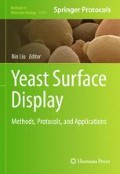Abstract
B7-H4 (VTCN1, B7x, B7s) is an inhibitory modulator of T-cell response implicated in antigen tolerization. As such, B7-H4 is an immune checkpoint of potential therapeutic interest. To generate anti-B7-H4 targeting reagents, we isolated antibodies by differential cell screening of a yeast-display library of recombinant antibodies (scFvs) derived from ovarian cancer patients and we screened for functional scFvs capable to interfere with B7-H4-mediated inhibition of antitumor responses. We found one antibody binding to B7-H4 that could restore antitumor T cell responses. This chapter gives an overview of the methods we developed to isolate a functional anti-B7-H4 antibody fragment.
Access this chapter
Tax calculation will be finalised at checkout
Purchases are for personal use only
References
Sica GL, Choi IH, Zhu G et al (2003) B7-H4, a molecule of the B7 family, negatively regulates T cell immunity. Immunity 18:849–861, doi:S1074761303001523 [pii]
Prasad DV, Richards S, Mai XM et al (2003) B7S1, a novel B7 family member that negatively regulates T cell activation. Immunity 18:863–873, doi:S107476130300147X [pii]
Zang X, Loke P, Kim J et al (2003) B7x: a widely expressed B7 family member that inhibits T cell activation. Proc Natl Acad Sci U S A 100:10388–10392. doi:10.1073/pnas.1434299100, 1434299100 [pii]
Kryczek I, Wei S, Zou L et al (2006) Cutting edge: induction of B7-H4 on APCs through IL-10: novel suppressive mode for regulatory T cells. J Immunol 177:40–44, doi:177/1/40 [pii]
Tringler B, Zhuo S, Pilkington G et al (2005) B7-h4 is highly expressed in ductal and lobular breast cancer. Clin Cancer Res 11:1842–1848. doi:10.1158/1078-0432.CCR-04-1658, 11/5/1842 [pii]
Kryczek I, Zou L, Rodriguez P et al (2006) B7-H4 expression identifies a novel suppressive macrophage population in human ovarian carcinoma. J Exp Med 203:871–881. doi:10.1084/jem.20050930, jem.20050930 [pii]
Choi IH, Zhu G, Sica GL et al (2003) Genomic organization and expression analysis of B7-H4, an immune inhibitory molecule of the B7 family. J Immunol 171:4650–4654
Sun Y, Wang Y, Zhao J et al (2006) B7-H3 and B7-H4 expression in non-small-cell lung cancer. Lung Cancer 53:143–151. doi:10.1016/j.lungcan.2006.05.012, S0169-5002(06)00231-5 [pii]
Quandt D, Fiedler E, Boettcher D et al (2011) B7-h4 expression in human melanoma: its association with patients’ survival and antitumor immune response. Clin Cancer Res 17:3100–3111. doi:10.1158/1078-0432.CCR-10-2268, 1078-0432.CCR-10-2268 [pii]
Krambeck AE, Thompson RH, Dong H et al (2006) B7-H4 expression in renal cell carcinoma and tumor vasculature: associations with cancer progression and survival. Proc Natl Acad Sci U S A 103:10391–10396. doi:10.1073/pnas.0600937103, 0600937103 [pii]
Jiang J, Zhu Y, Wu C et al (2010) Tumor expression of B7-H4 predicts poor survival of patients suffering from gastric cancer. Cancer Immunol Immunother 59:1707–1714. doi:10.1007/s00262-010-0900-7
Miyatake T, Tringler B, Liu W et al (2007) B7-H4 (DD-O110) is overexpressed in high risk uterine endometrioid adenocarcinomas and inversely correlated with tumor T-cell infiltration. Gynecol Oncol 106:119–127. doi:10.1016/j.ygyno.2007.03.039, S0090-8258(07)00198-9 [pii]
Zang X, Thompson RH, Al-Ahmadie HA et al (2007) B7-H3 and B7x are highly expressed in human prostate cancer and associated with disease spread and poor outcome. Proc Natl Acad Sci U S A 104:19458–19463. doi:10.1073/pnas.0709802104, 0709802104 [pii]
van der Meel R, Gallagher WM, Oliveira S et al (2010) Recent advances in molecular imaging biomarkers in cancer: application of bench to bedside technologies. Drug Discov Today 15:102–114. doi:10.1016/j.drudis.2009.12.003, S1359-6446(09)00405-X [pii]
Porter DL, Kalos M, Zheng Z et al (2011) Chimeric antigen receptor therapy for B-cell malignancies. J Cancer 2:331–332
Dangaj D, Lanitis E, Zhao A et al (2013) Novel recombinant human b7-h4 antibodies overcome tumoral immune escape to potentiate T-cell antitumor responses. Cancer Res 73:4820–4829. doi:10.1158/0008-5472.CAN-12-3457
Zhao A, Nunez-Cruz S, Li C et al (2011) Rapid isolation of high-affinity human antibodies against the tumor vascular marker Endosialin/TEM1, using a paired yeast-display/secretory scFv library platform. J Immunol Methods 363:221–232. doi:10.1016/j.jim.2010.09.001, S0022-1759(10)00239-5 [pii]
Scholler N (2012) Selection of antibody fragments by yeast display. Methods Mol Biol 907:259–280. doi:10.1007/978-1-61779-974-7_15
Durocher Y, Perret S, Kamen A (2002) High-level and high-throughput recombinant protein production by transient transfection of suspension-growing human 293-EBNA1 cells. Nucleic Acids Res 30:E9
Lanitis E, Poussin M, Hagemann IS et al (2012) Redirected antitumor activity of primary human lymphocytes transduced with a fully human anti-mesothelin chimeric receptor. Mol Ther 20:633–643. doi:10.1038/mt.2011.256, mt2011256 [pii]
Dangaj D, Abbott KL, Mookerjee A et al (2011) Mannose receptor (MR) engagement by mesothelin GPI anchor polarizes tumor-associated macrophages and is blocked by anti-MR human recombinant antibody. PLoS One 6:e28386. doi:10.1371/journal.pone.0028386, PONE-D-11-09405 [pii]
Author information
Authors and Affiliations
Corresponding author
Editor information
Editors and Affiliations
Rights and permissions
Copyright information
© 2015 Springer Science+Business Media New York
About this protocol
Cite this protocol
Dangaj, D., Scholler, N. (2015). Isolation and Validation of Anti-B7-H4 scFvs from an Ovarian Cancer scFv Yeast-Display Library. In: Liu, B. (eds) Yeast Surface Display. Methods in Molecular Biology, vol 1319. Humana Press, New York, NY. https://doi.org/10.1007/978-1-4939-2748-7_2
Download citation
DOI: https://doi.org/10.1007/978-1-4939-2748-7_2
Publisher Name: Humana Press, New York, NY
Print ISBN: 978-1-4939-2747-0
Online ISBN: 978-1-4939-2748-7
eBook Packages: Springer Protocols

